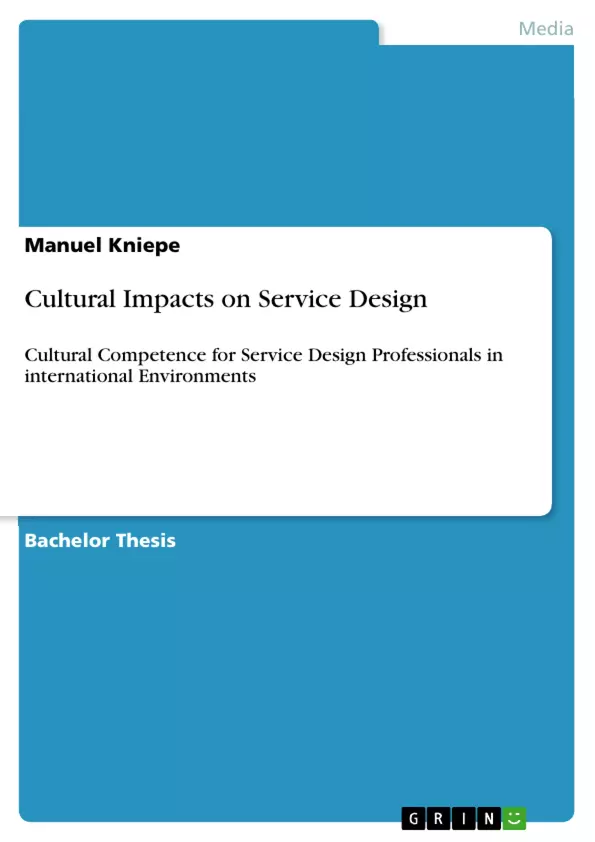Nowadays companies are faced with the challenge to successfully place their services and service products in highly competitive local as well as global markets. Therefore this challenge also applies for service designers in established markets and for service design pioneers in emerging markets. With user experience and customer centered approaches becoming increasingly important business factors, proceeding globalization demands a better understanding of how cross-cultural differences shape the way services are used and how they are created.
New and emerging service markets like India and China rise the demand for internationally working service designers to incorporate cultural aspects in their process to stay competitive and to nurture and grow the service design sector in untouched markets. Examples from practice in Asia have shown that service providers as well as service users reject approaches which don’t resonate with their culture.
Cross-cultural tools, such as the cultural dimensions, are used by International Management for decades in order to allow efficient management of multicultural teams and organizations. Their main fields of application certainly lies in business, but in recent years they are also used by design disciplines. Since service design connects design and businesses, it seems to be predestined for a possible application of cultural dimensions.
Therefore one the main question of this research paper is whether methods from international management, cultural dimensions to be more specific, can be applied to service design and how internationally active service design providers have to adapt their process of service design to specific cultures.
Inhaltsverzeichnis (Table of Contents)
- A - Preface
- Chapter 1 - Introduction
- 1.1 - Culture in a Nutshell
- 1.2 - What is Service Design?
- Chapter 2 - Culture in Detail
- 2.1 The Hofstede Model
- 2.2 - F. Trompenaars' & C. Hampden-Turner's Model
- 2.3 Culture repeats itself.
- 2.4 - Why Stereotypes are dangerous.
- 2.5 Cultural Competence by Cultural Dimensions.
- 2.6 - Advantages of a Global Mindset.
- 2.7 Conclusion
- Chapter 3 - Being Human in Service Design
- 3.1 - Human Interactions in Process Stages
- 3.2 Stakeholder Relations
- 3.3 Co-Creation means Value-Creation.
- 3.4 – Increase Value with Relations & Interactions
- 3.5 – Using Cultural adequate Management as Catalyst
- 3.6 Conclusion
- Chapter 4- Cultural Dimensions
- 4.1 - Hofstede's six Cultural Dimensions.
- 4.2 Trompenaars' seven Cultural Dimensions
- 4.3 - Critical Remarks on Cultural Dimension Models
- 4.4 - There is no Right nor Wrong
- Chapter 5 - Cultural Dimensions in Service Design
- 5.1 Cross-Cultural Feedback Structures.
- 5.2 Quantitative Research vs. Qualitative Research
- 5.3 About Cultural Immersion.
- 5.4 - Time to chose: Trompenaars or Hofstede?
- 5.5 Merging both Models
- 5.6 Applying Cultural Dimensions
- Chapter 6 - Concluding Thoughts, further Development
Zielsetzung und Themenschwerpunkte (Objectives and Key Themes)
This research paper examines the impact of cultural differences on service design, specifically focusing on the needs of service design professionals working in international environments. It investigates whether cultural dimensions, a tool frequently utilized in international management, can be applied effectively to service design and how service design providers must adapt their processes to diverse cultural contexts.
- Understanding the role of culture in shaping service design processes and outcomes.
- Exploring the applicability of cultural dimension models in international service design projects.
- Analyzing the importance of cultural competence for service design professionals.
- Identifying key cultural dimensions and their influence on service design practices.
- Developing strategies for adapting service design processes to cultural differences.
Zusammenfassung der Kapitel (Chapter Summaries)
This bachelor proposal explores the impact of culture on service design in international contexts. Chapter 1 introduces the concepts of culture and service design, setting the foundation for the investigation. Chapter 2 delves deeper into the concept of culture, examining two prominent cultural dimension models – the Hofstede Model and Trompenaars & Hampden-Turner's Model. It discusses the importance of cultural competence and the advantages of a global mindset in service design.
Chapter 3 explores the role of human interactions in service design, highlighting the significance of stakeholder relations and co-creation in value creation. It emphasizes the need for cultural-sensitive management practices to optimize service design outcomes. Chapter 4 presents a detailed analysis of Hofstede's six cultural dimensions and Trompenaars' seven cultural dimensions, offering a comprehensive framework for understanding cultural differences. It also addresses critical remarks on cultural dimension models.
Chapter 5 focuses on the application of cultural dimensions to service design. It explores cross-cultural feedback structures, quantitative and qualitative research methods, and cultural immersion techniques. It also discusses strategies for integrating different cultural dimensions into service design projects.
Schlüsselwörter (Keywords)
This research focuses on the impact of cultural differences on service design, analyzing cultural dimensions, cultural competence, global mindset, stakeholder relations, co-creation, international service design, cultural adaptation, cross-cultural communication, and cultural immersion.
- Quote paper
- Manuel Kniepe (Author), 2018, Cultural Impacts on Service Design, Munich, GRIN Verlag, https://www.grin.com/document/423526



